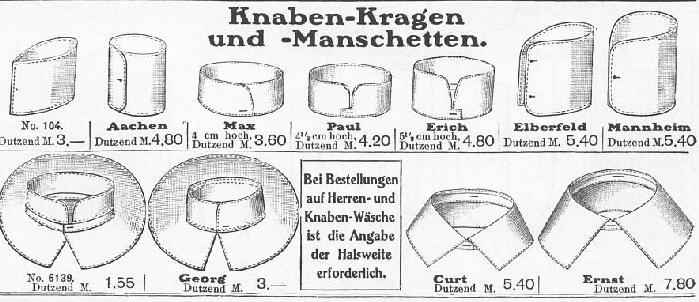
German Catalogs with Boys Clothings: A. Wertheim 1903 Catlog--Collars

Figure 1.--German boys wore a variety of shirts and blouses. Many shirts came without collars. We notice detachable collars in several different styles. This was quite common at the time and we notice them in other countries. We notice examples from the the German wholesale company A. Wertheim in Berlin. They were offered from their 1903-04 catalog. Wertheim does not use standard terms for the different collars, but rather proper names. These were presumably store names and not standard German terms.
|
German boys wore a variety of shirts and blouses. Many shirts came without collars. We notice detachable collars in several different styles. This was quite common at the time and we notice them in other countries. We notice examples from the the German wholesale company A. Wertheim in Berlin. They were offered from their 1903-04 catalog. Wertheim does not use standard terms for the different collars, but rather proper names. These were presumably store names and not standard German terms.
A. Wertheim
A Wertheim was located in Berlin. Wertheim was untill the 1930s one of the big department stores (Warenhaus). The most famous was the "Kaufhaus des Westens" (KadeWe) in
Berlin (now owned by Karstadt). Like many of the important department stores they also had a catalog so customers outside Berlin could order their merchandice. The Wertheim wwere a Jewish family. Their store was Aryanized by the NAZIs during the Third Reich. There are still law suits in process to reimburse them.
Knaben Kragen und Manschettens
German boys wore a variety of shirts and blouses. Many shirts came without collars. The section is labeled Knaben Kragen und Manschettens. That means boys' collars and ????. Some are a little different than the collars we have noted in American catalogs in that they are attached to a much wide piece which appears to fit over the shoulders. Some ot the items are quite hall, they may be sleeve cuffs to match the collars. We are not sure about that.
Styles
We notice detachable collars in several different styles.
This was quite common at the time and we notice them in other countries. We notice examples from the the German wholesale company A. Wertheim in Berlin. They were offered from their 1903-04 catalog. Wertheim does not use standard terms for the different collars, but rather proper names. These were presumably store names and not standard German terms. One of the collars attached to shoulder pieces is called Georg and two collars that look lije Eton collars are called Curt and Ernst. (We are not sure what the German term is for Eton collar.)
HBC

Navigate the Boys' Historical Clothing catalog/magazine pages:
[Return to the Main German 1903 catalog page]
[Main photo/publishing page]
[Store catalogs]
[Fashion magazines]
Navigate the Boys' Historical Clothing Web Site:
[Introduction]
[Activities]
[Biographies]
[Chronology]
[Clothing styles]
[Countries]
[Topics]
[Bibliographies]
[Contributions]
[FAQs]
[Glossaries]
[Satellite sites]
[Tools]
[Boys' Clothing Home]
Navigate the Boys' Historical Clothing Web Site:
[Sailor suits]
[Sailor hats]
[Buster Brown suits]
[Eton suits]
[Rompers]
[Tunics]
[Smocks]
[Pinafores]
Created: 11:48 PM 10/30/2005
Last updated: 11:48 PM 10/30/2005



